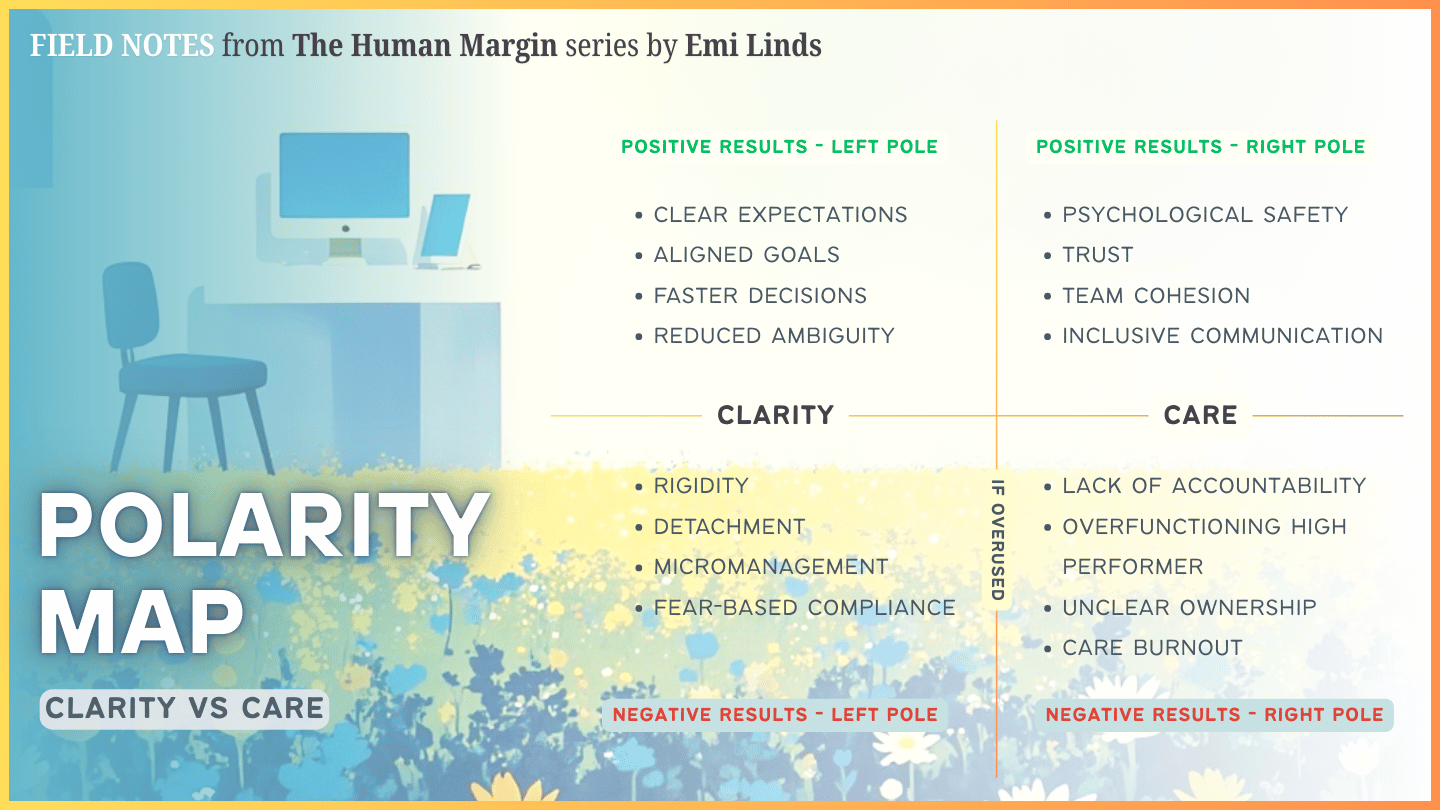When decisions involve competing truths, we don’t need a stronger opinion. We need a better question.
I work at the intersection of strategy, creative, and technology. Tension is a constant: between long-term positioning and short-term targets, between what resonates and what performs.
Over the years, I’ve learned that the best decisions rarely come from consensus. They come from learning to hold contradictions and still moving forward.
That’s why polarity mapping is part of my strategic toolkit.
In cross-functional teams, tension is a given: between speed and stability, alignment and autonomy. Some call that dysfunction; I see it as complexity revealing human tensions.
What is polarity mapping?
Originally developed by Barry Johnson, polarity mapping is a tool that helps organizations manage competing values that are both essential and interdependent. When you’re solving problems with interdependent costs, constraints, and consequences, polarity mapping supports more balanced decisions over time.
Some common polarities include:
- Legacy vs. Innovation
- Empathy vs. Accountability (or care vs. clarity)
- Autonomy vs. Collaboration
Each side of a polarity has an upside when embraced and a downside when overused or isolated. Holding complexity means learning how to leverage both while minimizing the cost of extremes.
Where this fits
Polarity mapping is one tool in the Decision Frameworks pillar of The Human Margin Clarity System – a systems approach I use to scale trust in complex environments. Decision frameworks are designed to reduce friction from decision-making. Polarity mapping helps by creating shared visibility: What are we balancing? Where are we over-extending? What does “too much” of a good thing cost?
Why this matters to you
Many teams fall into what’s known as the planning stress cycle: rigid strategies built on single-sided optimization. When the environment shifts (as it always does), the plan breaks down, and productivity suffers. You’ve seen this before: lots of rework happens, morale dips, and burnout starts brewing.
Polarity mapping helps by holding both sides of a tension in view.
The framework in action
In visual form, polarity maps consist of four quadrants:
- Top left: Upside of Pole A
- Top right: Upside of Pole B
- Bottom left: Downside of over-focusing on Pole A
- Bottom right: Downside of over-focusing on Pole B
This framework encourages collaborative thinking and adaptive planning – both are critical for modern leadership.

A real example: Clarity and Care
I’ve seen situations where “care” was the default mode—everyone was thoughtful, considerate, and generous. However, hard conversations were delayed, resentment started brewing, and leaders quietly burned out from over-functioning.
I’ve also seen the reverse: clarity so sharp it reduced humanity to digits. It was efficient and fast, but emotionally costly and ethically fragile.
Polarity mapping helped reframe the conversation. Instead of debating which approach was better, I asked:
“What’s the upside of both? And what’s the cost of overusing either?”
That one shift moved us from compromise to integration.
How to use a polarity map
Adapted from Crofton (2023):
- Define the challenge: What tension keeps coming up and isn’t resolvable by choosing one side?
- Identify the polarity: Are both poles necessary and interdependent? Can overuse of either create risk?
- Name the poles neutrally: Use “Stability” vs. “Change”. Avoid charged labels like “Complacency” vs. “Progress.”
- Map the quadrants: Brainstorm the upsides and downsides of each pole, first individually, then together.
- Agree on a higher purpose: Why are you managing this polarity? What future or value is at stake?
- Set early warning signs: How will you know when you’re leaning too far into one side?
- Design responsive actions: Choose real-world steps that allow you to shift gracefully, not reactively.
Tensions will always be around, because they are deeply human.
The best leaders I’ve worked with manage decisions while holding contradicting tensions.
Polarity mapping is one small tool to support that work.
—
From someone building clarity systems for complex human tensions.
#TheHumanMargin #StrategicThinking #DecisionMaking #AdaptiveLeadership
References
Crofton, J.-P. (2023, March 26).
What is polarity management? A beginner’s guide to create a balanced strategy.
Edge of Possible Consultancy.
https://edgeofpossible.com/what-is-polarity-management/
Johnson, B. (1992).
Polarity management: Identifying and managing unsolvable problems.
HRD Press.
